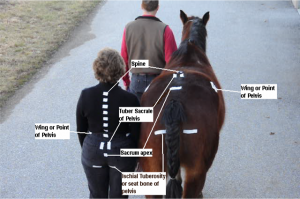Chiropractic adjustment or manipulation improves the horse’s musculoskeletal function thereby influencing the rider’s own nervous system input. Motion creates over 90% of the input into the brain and spinal cord. Normal motion of the body sends nervous impulses maintaining health of the nervous system and body function. A large percentage of motion nervous imput originates from the muscle spindle cells as they respond to gravity. Chiropractic adjustment returns the joint’s function to its full range of motion to maximize input into the nervous system. The integrity and function of the nervous system is improved with use. Consequently, riding a horse especially in the case of therapeutic riding programs has a great benefit in waking up and building alternate nervous system pathways in the rider. As a side note, it would be interesting to know if the incidence of neural disease like Alzheimer’s or Parkinson’s is lower in the human population that ride horses verses those people who do not ride horses.

Chiropractic adjustment or manipulation improves the human neurological function and the horses bio-mechanical function by increasing joint motion. The following videos demonstrate the similarities of motion between the human and horse. The videos also illustrate the change made with a chiropractic manipulation of the horse. We first identified similar locations on horse and rider to show how similar the same points move. This photo compares the location of the prominent pelvic and spinal landmarks in a human and horse. By identifying the landmarks with white tape, we can better see how they move and compare the horse and rider at a walk.
Pre Adjusting Walking:
As the pre-chiropractic adjustment video is played, note the sacrum moves in a figure 8 motion as illustrated by the sacrum apex tape. The pelvis rocks up and down illustrated by the tape on the wing of the pelvis, Tuber sacrale, and Ischial tuberosity or seat bone. Also, you can see the spine oscillate from side to side going toward the skull. The motion is similar in both species.
Pre Adjust with Rider:
The second video illustrates the horse creating the same pelvic rocking and spinal oscillation as if the rider was walking. The motion produces a neural input into the rider’s nervous system which can wake up and build new nervous system pathways. The benefit of such motion can have significant results for a paraplegic or individual with a neural disorder along with benefits for a “healthy” rider.
Post Chiropractic Adjustment with Rider:
The only change between the second and third video will be that the horse had a chiropractic treatment resulting in a significant change to the horse’s bio-mechanical movement. If you compare the videos you will see the figure 8 movement of the sacral apex and tail away from mid-line is an equal distance left to right. The vertical movement of the wing of the pelvis and the Ischial tuberosity is the same on each side. The balanced horse movement imparts to the rider’s pelvis a larger vertical movement and symmetrical oscillation of the rider’s spine to the skull.
The videos confirm the horse’s improved bio-mechanical movement after the chiropractic adjustments. The horse’s discipline of use does not matter, improved bio-mechanical function means improved performance and balance for the horse. Better bio-mechanical function of the horse’s gait results in less leg joint trauma and the need for joint injections or maintenance in the horse. As a benefit the rider experiences a normal balanced movement of their pelvis and spine producing normal neural input and improved nervous system health.
